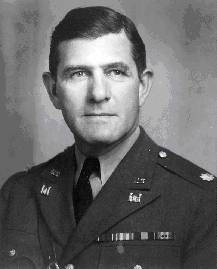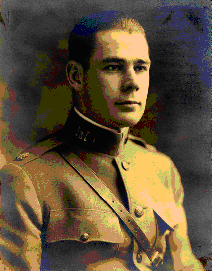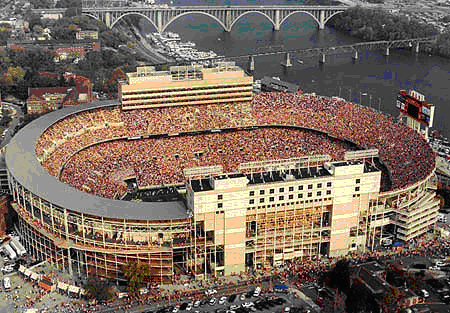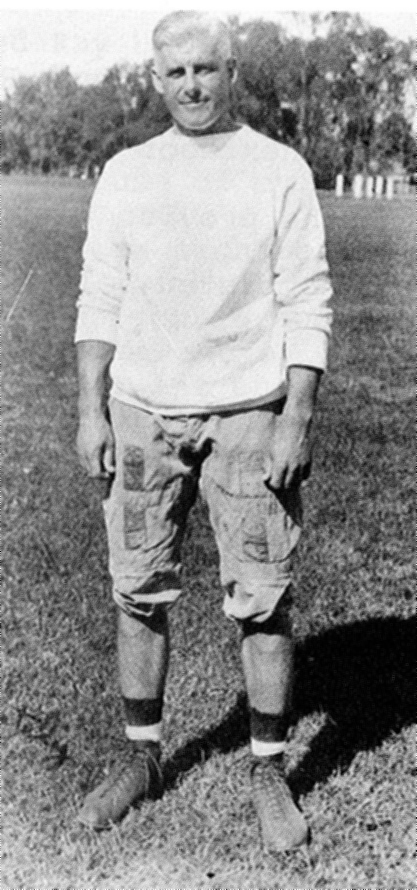For a start, take Michie Stadium at the U.S. Military Academy, West Point. The stadium was named for an infantryman, Dennis Mahan Michie, class of 1892, who was killed in action during the Spanish-American War. Michie’s father, Peter, was an engineer from the class of 1863 and served as Chief Engineer, Army of the James, during the Civil War. After the war Peter returned to West Point as a professor of engineering from 1867 to 1901. Michie’s godfather, Dennis Hart Mahan, was Professor and Head of the Department of Military Art and Engineering at West Point from 1824 to 1871.
| |
 |
| |
William M. Hoge |
Additionally, in the long history of the Corps, there were three engineers who created a direct relationship between the Corps and college football. William M. Hoge was a member of the West Point class of 1916. A back, Hoge watched the first Notre Dame–Army game from the bench in 1913, but in 1914, a National Championship year, and 1915, he was a starter in all games. Set to go into the artillery at graduation, Hoge chose engineers on the advice of a teammate. He went to France as a company commander in the 7th Engineer Regiment and won a Silver Star in the St. Mihiel Offensive. During the Meuse-Argonne Offensive he won a Distinguished Service Cross as a battalion commander. After the war he taught at the Infantry School, Fort Benning where he rubbed elbows with Marshall, Bradley, and Stilwell. He went to the Philippines to command the 14th Engineer Regiment where he worked with MacArthur and Eisenhower. At the start of World War II he commanded the troops building the Alaska Highway, and in 1943 went to England to prepare the amphibian engineers for D-Day. He commanded the Provisional Engineer Special Brigade Group at Omaha Beach, and in November 1944 joined the 9th Armored Division in time for the Bulge. In March 1945 his Combat Command B seized the Rhine River Ludendorff Railroad Bridge at Remagen. During the Korean War Hoge commanded the IX Corps and then went to Germany to first command the Seventh Army and then to serve as CINCUSAREUR. William M. Hoge retired in 1955 as a four-star general.
| |
 |
| |
Robert R. Neyland |
The football teammate who influenced Bill Hoge to enter the Corps was Robert R. Neyland, an end from the class of 1916. Bob Neyland went to France as an instructor in the First Army Engineer School during World War I. After the war he was an aide to the Superintendent of West Point, Douglas MacArthur, and served as an assistant football coach. Wanting to continue coaching, he became the Professor of Military Science and assistant football coach at the University of Tennessee. Hired as the head coach in 1926, Neyland’s teams won more than sixty games and lost only seven in a nine-year span. After a one-year tour in Panama, Neyland retired as a major in 1936 to devote his full time to coaching football at Tennessee. His 1938 team was unbeaten and the 1939 team was unscored upon and unbeaten. Recalled to active duty in 1941 as the Commanding Officer, Southwestern Engineer Division, Neyland went to India as Commanding General Base Section in 1944. Neyland retired for a second time from the Corps in 1946 as a brigadier general and returned to coaching football at Tennessee. It took him five years to get his team back to a pre-war level, but in 1950 he won eleven and lost only once. In 1951 he went undefeated and won a National Championship. When he retired from coaching to become athletic director in 1953 his record stood at 173 wins, 31 losses, 12 ties, and no losing seasons. Neyland Stadium, home of the Volunteers of the University of Tennessee, is named for him.

Neyland Stadium, University of Tennessee
| |
 |
| |
West Point's head coach Davidson, 1933 |
One of the players who Neyland coached when he was an assistant at West Point was Garrison H. Davidson, an end in the class of 1927. Gar Davidson scored the first Army touchdown in the newly-dedicated Michie Stadium during the 1924 season. Upon graduation he intended to go into the infantry, but his coach, Biff Jones, suggested engineers. From 1927 to 1929 Davidson was in the 1st Engineer Regiment, Fort DuPont, Delaware, and served as an assistant coach to the Army football team. From 1930 to 1932 he was in the Physics Department and continued as an assistant coach. West Point hired him as head coach in 1933. He was a 1st Lieutenant of Engineers. His first team was undefeated until the last two minutes of the last game when Notre Dame blocked a kick and won 13 to 12. Davidson coached through the 1937 season, and his record of 35 wins, 11 losses, and 1 tie rank him among the top three Army coaches with Biff Jones and Earl “Red” Blaik. In 1938 Davidson went to Hawaii as a company commander in the 3d Engineer Regiment, and early in World War II he was working for Leslie Groves building the Pentagon when George Patton selected him to be deputy engineer for Western Task Force in the invasion of North Africa. He was Seventh Army Engineer for the Sicily campaign and served in that capacity to the end of the war. He went to Korea as Assistant Division Commander of the 24th Infantry Division in 1950, and after a two-year tour as Commandant of the Command and General Staff College, he returned to West Point as Superintendent in 1956. He then commanded the Seventh Army in Germany and the First Army in the United States and retired in 1964 as a Lieutenant General.
* * *
November 2001